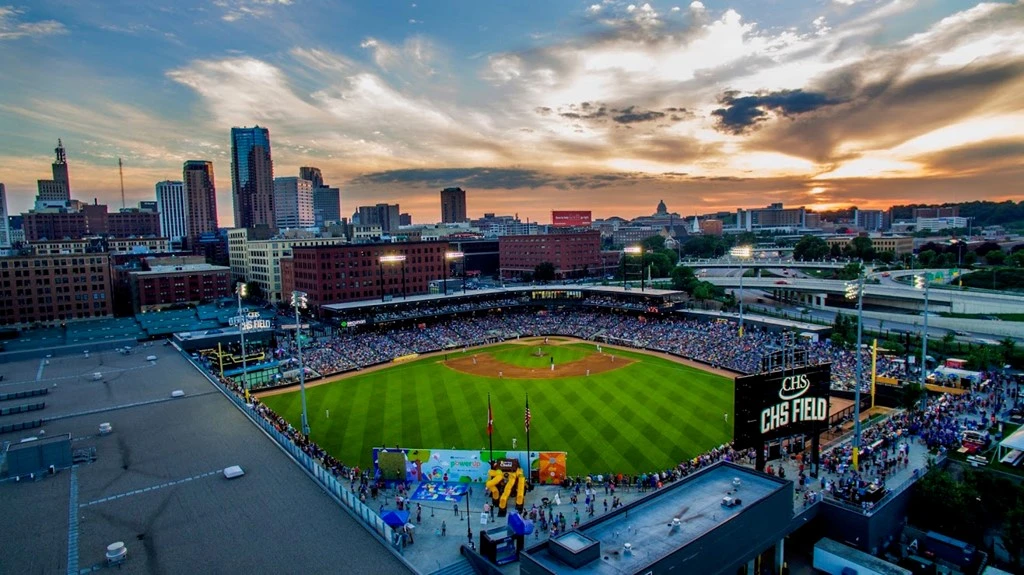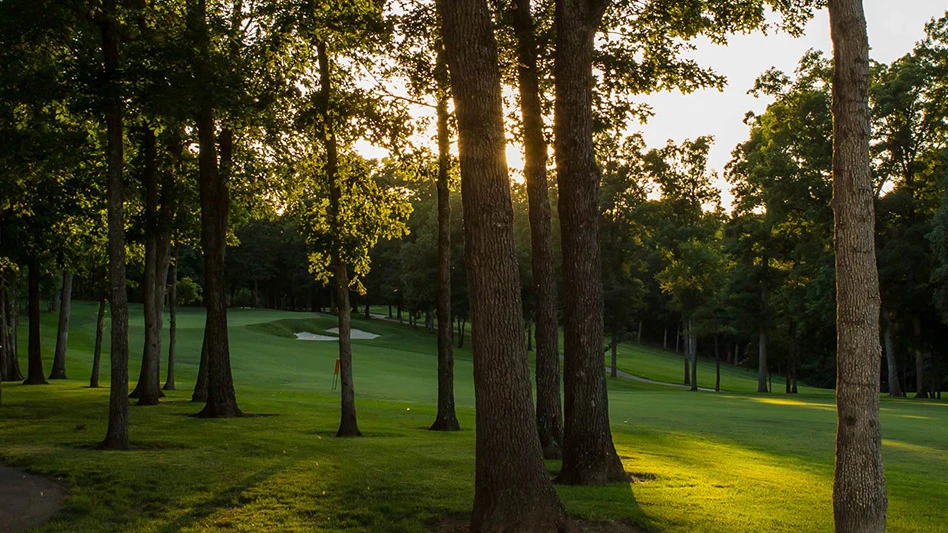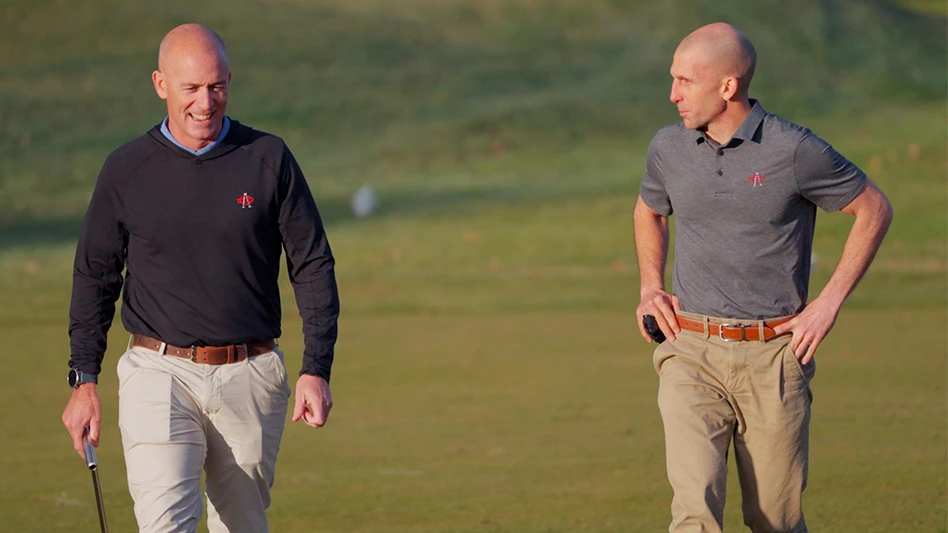
Courtesy of the St. Paul Saints
Golf and baseball aren’t all that different. Both require a sweet swing. Both go just a little better with a beer or three. And both are played on beautiful blankets of green grass. Course superintendents and ballpark groundskeepers aren’t all that different either. We talked with three top groundskeepers — starting with Matt Parrott, who moved south from the Double-A Bowie Baysox to the Triple-A Charlotte Knights in 2016, and who has been named the best groundskeeper in his league five times in the last nine seasons — for stories from another side of turf maintenance.
I built a pitcher’s mound at my house when I was 12 years old. That’s how I started.
I’ve played golf my whole life, I’ve just never actually worked on a golf course. I got into this to go down that path, but when I was in school, I made the decision that I enjoyed playing golf too much that I was afraid working in the industry would jade me a little bit.
I went to Appalachian State and didn’t know what I wanted to do so I got a business degree — figured it would be beneficial — and all through college, I worked on fields. I decided to go straight from my business degree to N.C. State. I got my associate’s degree in turf and the rest is history. Twenty years.
You get out here and start working, and you learn real quick.
It’s not as much you as it is the people you surround yourself with.
From a resource standpoint, we’re very fortunate — with the staff we have, the staff size. Ultimately, somebody does have to make the decisions on a daily basis, but you can only be successful if you set yourself up to be.
Fulltime, it’s a salaried assistant and me, and then I’m pretty fortunate that I rent hourly labor. They’re mostly seasonal employees, but I am able to keep hourly staff on as needed throughout the year. So basically, right now, we’re running a payroll somewhere between 22 and 25 hourly employees. Now, we run shifts. We’ll bring in eight hourly guys starting at 5 o’clock, and we had four hourlies since 10 o’clock this morning, so it equates out to two seven-hour shifts, hence the reason for such a high number. We don’t have them here all the time.
With so many people on payroll now, it’s a lot of juggling and piecing together. You get halfway through the season and you’re just starting to figure out which crews are jelling together and you have to schedule based on that. If you have people who aren’t accustomed to working together on a regular basis, you’re less efficient.
We’re a John Deere fleet here and my John Deere rep — Rick Henderson, formerly of Skybrook (Golf Club) — is a former golf course superintendent. We struck up a friendship, and through him, I’ve had the fortune to meet some very high-caliber superintendents and get to know them.
There are some perks that come with the gig. I’ve gotten to play some really good golf courses in Charlotte.
There’s a lot of stuff in the golf industry that we’re trying to, as a collective group in sports turf, adopt from over there. I’d like to quit saying over there and for us to get on the same page in general.

Now in his second full season as head groundskeeper for the Albuquerque Isotopes — the Triple-A affiliate of the Colorado Rockies — Clint Belau has an interesting challenge at hand: turn the baseball field at Isotopes Park into a soccer pitch … almost a dozen times in five months. The standup comic-turned-bass player-turned-groundskeeper explains.
We work with a company called Mountain West Golfscapes. They’re local and they’re the ones who actually built the field. We have a trade with them, so they do our aerations throughout the year, they do a laser-grade every year, so I was real familiar with them on the front end, and then we all jumped into soccer together. They had never done a soccer transition, either, so everybody did a little bit of research on it.
We have a hill in centerfield, so we have to run from home plate to left field, which means we have to take out our mound every time. We’re on our fifth mound of the year right now. We’ve gotten pretty good at building mounds, whether we wanted to or not.
From a turf standpoint, I just try to do everything I can to stay beefed up, you know? Kind of adjusted the fertilizer program to add some things to help with growth. Being the first year, I didn’t know if it would be better to be tighter sideways and use growth regulators to get bluegrass to intertwine as much as I could, or to grow straight up and grow out of all the damage. So far, we’ve been fairly successful and I haven’t added any growth regulators into the program at all.
We have a baseball game, then two days of transition, then a soccer match, then two days of transition, and then baseball’s back, so we don’t have a lot of recovery time, and we don’t have as much detail time as we used to. It’s just kind of led to me — from that soccer match day almost until we’re back to baseball — just being here 24 hours straight.
All those things that we used to have six days for, we now have a day and a half for.
Since March 1, I’ve had one day off — Mother’s Day. If I worked that day, my wife would have killed me.
I’m a baseball guy. Soccer, you’re just taking care of a piece of grass. There are, like, six lines to paint, it’s just a big rectangle. If you can’t take care of a soccer field, you have to get out of the business. I’m sure they have their own challenges, too.
I grew up on a small family dairy farm, so the turf side of things is about as close to farming as I would ever want to be. Farming is difficult. Talk about not having a day off. Dad never had a day off. Makes you feel a lot less sorry about your situation — and I get to come to the ballpark every day.

After stints at Chisago Lakes Golf Course and the Grand Forks Park District, Marcus Campbell arrived in Minnesota in the spring of 2015 to become the director of grounds for the independent St. Paul Saints — whose ownership group includes the gregarious Mike Veeck (son of Bill and part of a four-generation family dynasty of baseball promoters) and a onetime golf tournament champion named Bill Murray.
The biggest challenge up here is the growing season being so short. If you’re down South, you have a little time to recoup after the season and get the grass growing, but up here, as soon as the field is clear, it’s gotta be ready to go. It’s hard to have the field look really nice when guys are tearing it up before it’s grown. We really only have a couple weeks that we aren’t using the field out of our growing.
It’s go go go all summer long. Winter’s a little more laid back.
When the team is on the road and we have time to do stuff, we slit seed quite a bit, just try to always have a seed bank going down. We do the whole field twice a year, usually spring and fall, and we’ll slit seed the whole field. We have a tow-behind slit seeder and we have a walk-behind slit-seeder, and we’ll use both of those during the season. We do heavy wear spots, and pretty much every week or every other week try to get a seed bank down so we constantly have stuff that’s trying to pop up in those heavy-wear areas. We just have to constantly pound those spots to try to get it to grow.
We don’t have as much time to sod. That’s the biggest issue for us. We have so many games that even if we did put sod down, it wouldn’t be healthy enough by the time someone’s playing on it, so we just keep pounding it with seed, hoping it fills in enough to get us through the season.
Even when I was a kid, before I knew I wanted to pursue this career, as soon as I walked into a ballpark, the first thing I was looking at were the stripes on the field or how the field looked. Now that I’m in this career, as soon as I walk into a ballpark, those are always the first things I look at. I always try to show up early, during batting practice, just to take time to hang out and look at the field, see what the guys working out there are doing. It’s kind of hard now to look at the field just as a fan.
In minor league baseball, especially with the Saints, we have a lot of guys who get their contracts purchased, and having guys come in who appreciate having a good field to play on so that they can get to the next level, that’s what drives you to make sure you’re doing your job right. It’s not only your career that’s on the line, and you’re helping them reach their goals, too.
Latest from Golf Course Industry
- Reel Turf Techs: Ron McCall
- TerraRad receives strategic investment from Old Tom Capital
- Beyond the Page 63: A different approach to labor
- 2025 Super Social Media Awards: Joshua Kelley
- Spanish Bay set for 2026-27 renovation
- An updated Iowa classic turns to Troon
- Introducing our January 2025 issue
- Bergin renovating Florida’s Golf Club at Crown Colony





